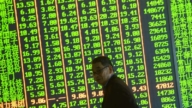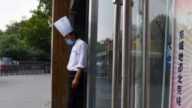【新唐人2013年01月21日讯】大陆国家统计局相继公布年度宏观经济、和居民收入基尼系数,以及劳动人口数变动等统计数据。不过这些数据,让经济学者批评﹕“连童话都不敢这么写!”也有专家认为,统计局为呈现“经济增速减缓”的真相,或防“水分过高”,只得“调控”出符合政策趋向的数据,也就是说,统计数据是“为政治服务”的。
有媒体质问﹕大陆官方经济数据究竟有多少水分?背后是否隐含着复杂“特殊国情”的政治考量﹖或者更有官僚体系浮夸自保的习性﹖
从最近大陆统计局公布的几个数据来看,有三个报跌的数据,包括GDP、基尼系数、和劳动年龄人口。经济界忙着分析这组数据的同时,也注意到当局公布数据背后的用意。
统计局公布,去年中国全年GDP增长7.8%。台湾《中国时报》引述大陆一位在部委任职人士的话说,多数省市自行初估的GDP增长都超过两位数,全国数据却能得出“破八”结论,背后自有反映“稳中求进”的政策考量。
《新唐人》特约经济评论专家杰森‧马表示,中国的经济数据,都是官方给出来的,缺乏可以参照的数据依据。
《新唐人》特约经济评论专家杰森‧马﹕“在(2012年)后半年,中共又开始调用它的老招数,靠给地方政府搞大型的基础建设,修公路,修一些乱七八糟的城市建设,用这种方法准备刺激经济,它只能靠这种非常低调的…政府往中国经济里头灌钱,用钱来刺激经济,用印钞票的方式来刺激经济,结果的话就是,一刺激,经济数据很好看的样子!老百姓的通胀就起来了,要是稍微控制通胀,中国经济又疲软了。”
近年中国贫富差距拉大,导致社会矛盾加剧。而贫富差距的测评系数,正是基尼系数。统计局报出的中国全国居民收入的“基尼系数”,从2003年的0.479,到2008年的0.491,然后“逐步回落”。当局否认贫富差距拉大。
大陆经济学家许小年在微博上说,那个基尼系数,“连童话都不敢这么写”。
民间普遍不相信官方数据,“西南财经大学”发布的“中国家庭金融调查”,2010年中国家庭基尼系数0.61,远远高于0.44的全球平均水准。报导说,中共当局刻意低估,显然有意粉饰贫富差距扩大的社会矛盾。
杰森‧马﹕“第一个是房地产的问题,08年、09年在中国经济刺激情况下,中国房地产暴涨,一定使中国经济整个贫富分化更严重,另外,在整个钞票过度发行过程中,相对来说,有投资渠道的人赚钱最多,而一般靠职工资,把钱存到银行的老百姓吃亏最大,应该也是证明中国贫富分化越来越严重。”
经济学博士、美国资深经济分析师 简天伦:“消费占国内生产总值GDP的比例,实际上是逐年下降,从70年代、60年代开始一直下降,下降到现在百分之30多一点,下降的原因,我觉得主要是分配的不公,就是收入的不均,尤其房价过高,所以他们很大一部分的收入都用于支付房价,还有医疗保险,还有教育等等。”
统计局还公布,中国人口2012年增加670万人,总人口达到13亿5400万人,不包括香港与澳门。不过15岁到59岁的劳动人口却减少345万人,来到9亿3700万人。这是中国劳动年龄人口,第一次出现了绝对下降。
简天伦:“换句话来说,就是过去的所谓独生子女政策的人口红利,给中国带来的GDP增长,现在已经成负效应,因为现在劳动人口实际上在下降,而且以后很可能还会持续下降。”
专家表示,劳动人口减少的同时,老年人口逐年增加,这是北京当局面临的重大挑战之一。各界担心中共当局如何照顾日益增多的老年人。大陆60岁以上老年人口已达1亿9400万人。
采访/朱智善 编辑/周平 后制/钟元
CCP’s Statistics to “Serve Its Political Needs”
China’s National Bureau of Statistics (NBS)
recently announced the latest economic data.
This included last year’s GDP, the Gini coefficient,
and the working-age population’ figure.
Economists question the authenticity of those numbers,
saying “they are more fictional than fantasy stories.”
Other experts remark that China’s NBS has to “adjust”
the statistics to accommodate the truth of “economic slowdown,” yet to avoid giving an inflated number.
In other words, the statistics have to meet
the political needs of the Chinese Communist Party (CCP).
Lately, some media reports queried again how real
the CCP’s official economic data is.
The article presented the following questions: Is there
any complex political considerations about “China’s special national situation” behind the statistics?
Has it reflected the boastfulness and the selfishness
of the CCP’s bureaucracy?
According to the data published by China’s NBS,
three numbers were reported to have dropped.
They are annual GDP growth, the Gini coefficient,
and the figure for working-age population.
Analyzing these statistics in depth, the economic circles
have noticed the regime’s real political purpose behind it.
The NBS officially announced that China’s GDP grew
by 7.8% in 2012.
Taiwan-based China Times newspaper cited an incumbent
mainland Ministry official that most provinces had estimated a double digit GDP growth.
However, the final number for the whole nation
dropped below 8%.
This clearly suggests that the political factors behind it
require the number to look more like a “steady advance.”
NTD special Economic Review Expert Jason Ma remarked,
all China’s economic data are given by the CCP regime, and thus lacks independent resources to compare with.
Jason Ma (NTD special Economic Review Expert):
”In the second half of 2012, the CCP dusted off its old tricks to stimulate the economy.
That is, to start more infrastructure local governments’
projects, like building roads or other unnecessary urban constructions.
This is the only approach it can think of.
The government continuously pours money into China’s
Economy, or simply prints more money as a stimulus.
As a result, very nice-looking economic data are produced
but the inflation becomes worse for ordinary people.
On the contrary, if you turn to solve the inflation issue,
the economy will be weakened.”
In recent years, the gap between rich and poor has widened
in China, leading to more intensive social conflicts.
The Gini coefficient is the index that measures
the level of inequality.
It is officially reported that China’s Gini coefficient of
national-wide personal income was 0.479 in 2003, then it increased to 0.491 in 2008, and dropped again after that.
In other words, the CCP authorities deny
that income inequality is growing in China.
Chinese economist Xu Xiaonian wrote on his microblog site,
“That (the official) Gini coefficient is more fictional than fantasy stories.”
Most Chinese civilians also show little faith
in the CCP’s statistics.
A China household finance survey performed by
Southwestern University of Finance and Economics,
reported that China’s household income’ Gini coefficient
was 0.61 in 2012, which was much higher than the global average of 0.44.
Some thus remarked that the CCP regime consciously
underestimates the Gini coefficient,
which obviously aimed at hiding the worse social conflicts
resulting from the larger gap between rich and poor.
Jason Ma: ”The first reason (for worse income inequality)
lies in the housing market.
Under the economic stimulus, there was a boom
in the real estate industry around 2008 and 2009.
This definitely increased the gap
between rich and poor.
In addition, during the excessive issue of currencies, people
with more available investment channels were capable of making more money.
In comparison, the working class who keep their money
in the bank suffered the most.
This also indicates that the gap between rich and poor
should have become larger in China.”
Jian Tianlun (PhD in Economics, senior economic analyst):
”In fact, China’s domestic consumption’ GDP contribution has been consistently dropping since the 1960’s-1970’s.
Now it has dropped to right over 30%.
I think the main reason for this drop is unfair distribution
of income, or income inequality.
In particular, the housing price is too high, and civilians
have to spend most of their income on buying a house.
There are also similar problems in other fields,
like health care and education.”
China’s NBS also reported that China’s total population
reached 1.354 billion in 2012, with an annual increment of 6.7 million.
Yet, the working population between the age of 15 and 59
had dropped by 3.45 million, reaching 0.937 billion.
This is the first time that China sees
a decline in working population.
Jian Tianlun: ”In other words, China’s GDP growth
used to benefit from the one-child policy.
Now its negative effect shows up as the working-age
population starts to decrease.
It is very probable that such a drop
will be a lasting trend.”
Expert remarks that the decreasing working population
and the increasing aging population has become a big challenge to the CCP.
It is especially worrying how the regime will take care
of those old people, as the population over 60 has totaled 194 million in mainland China.



























